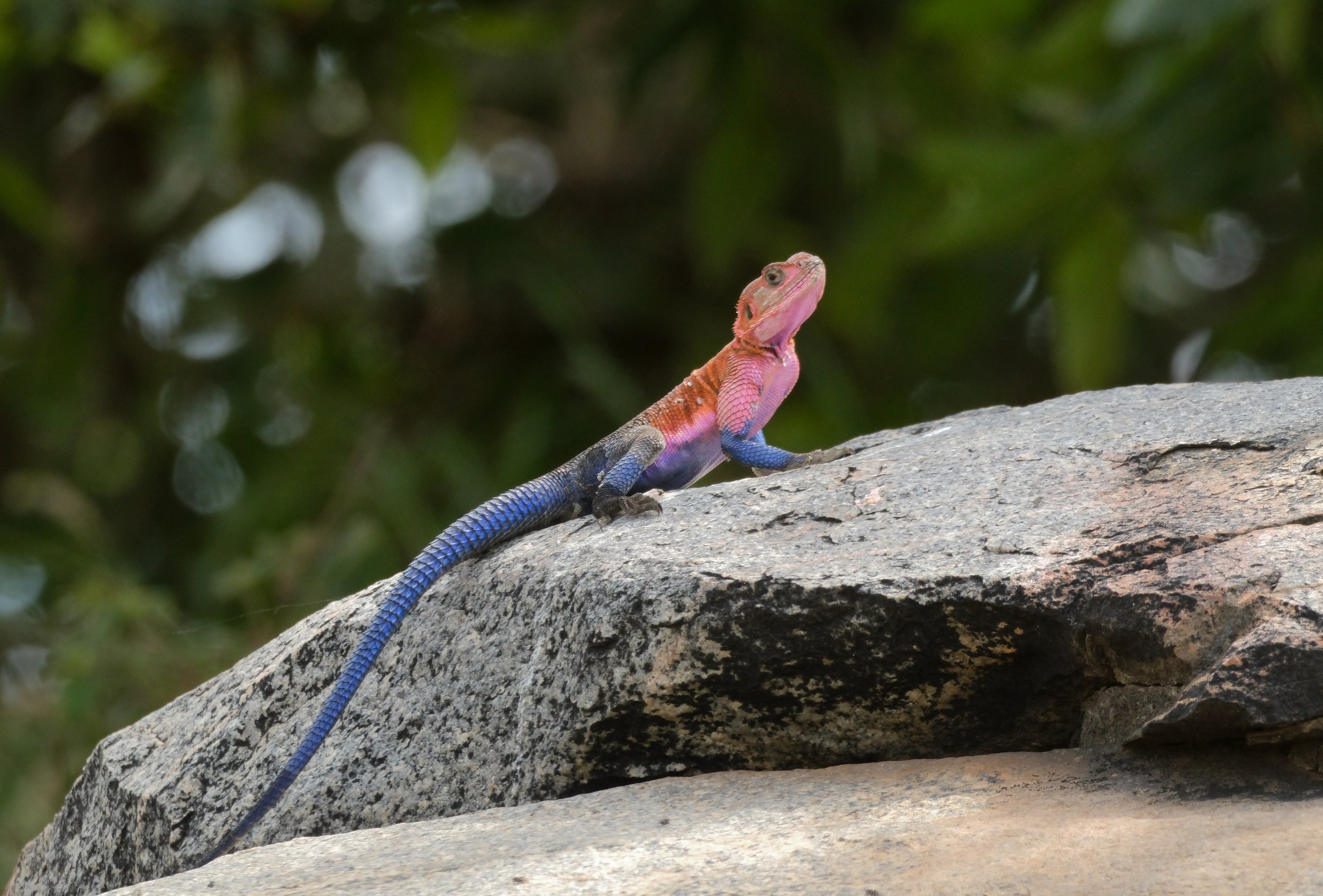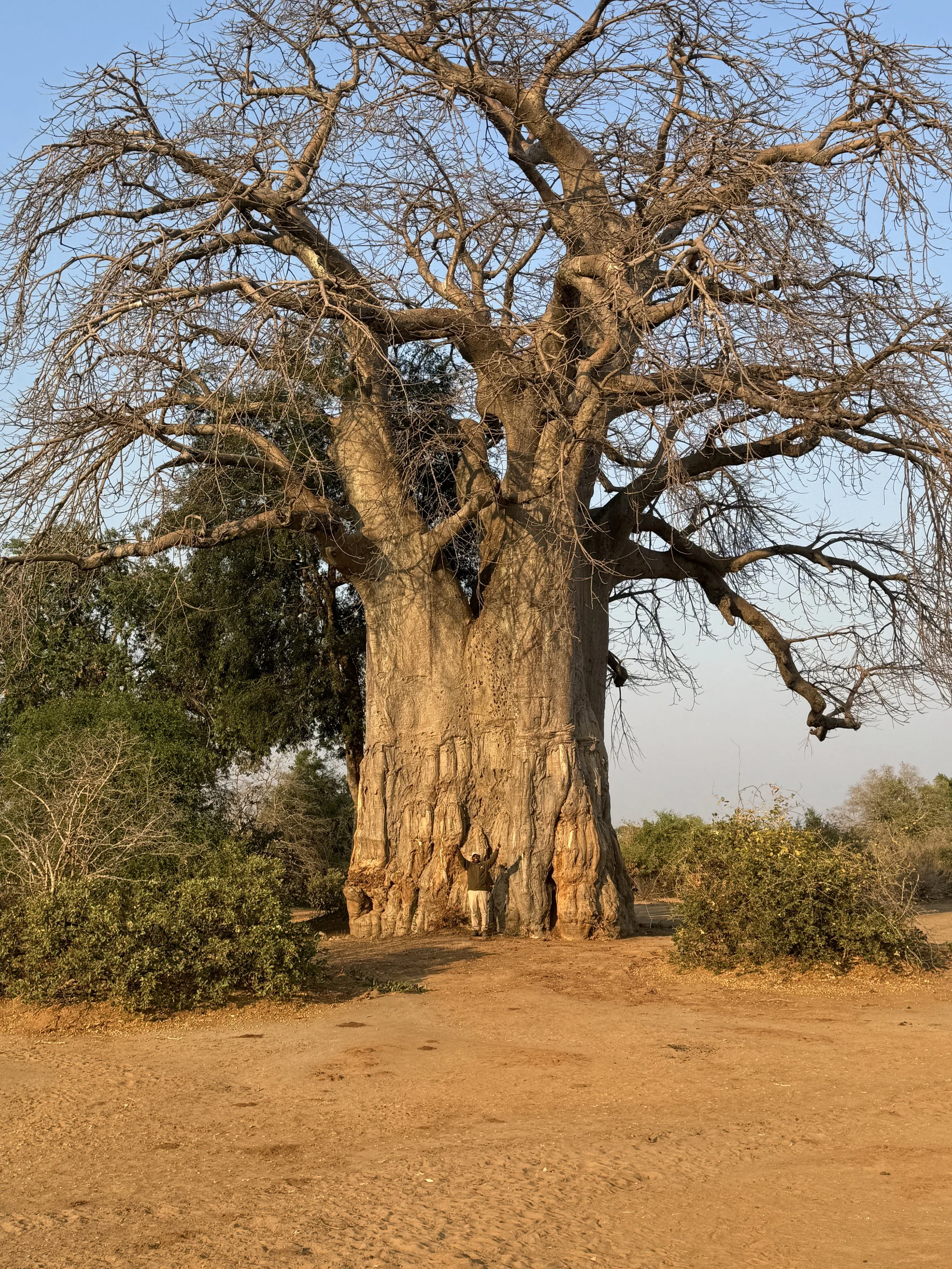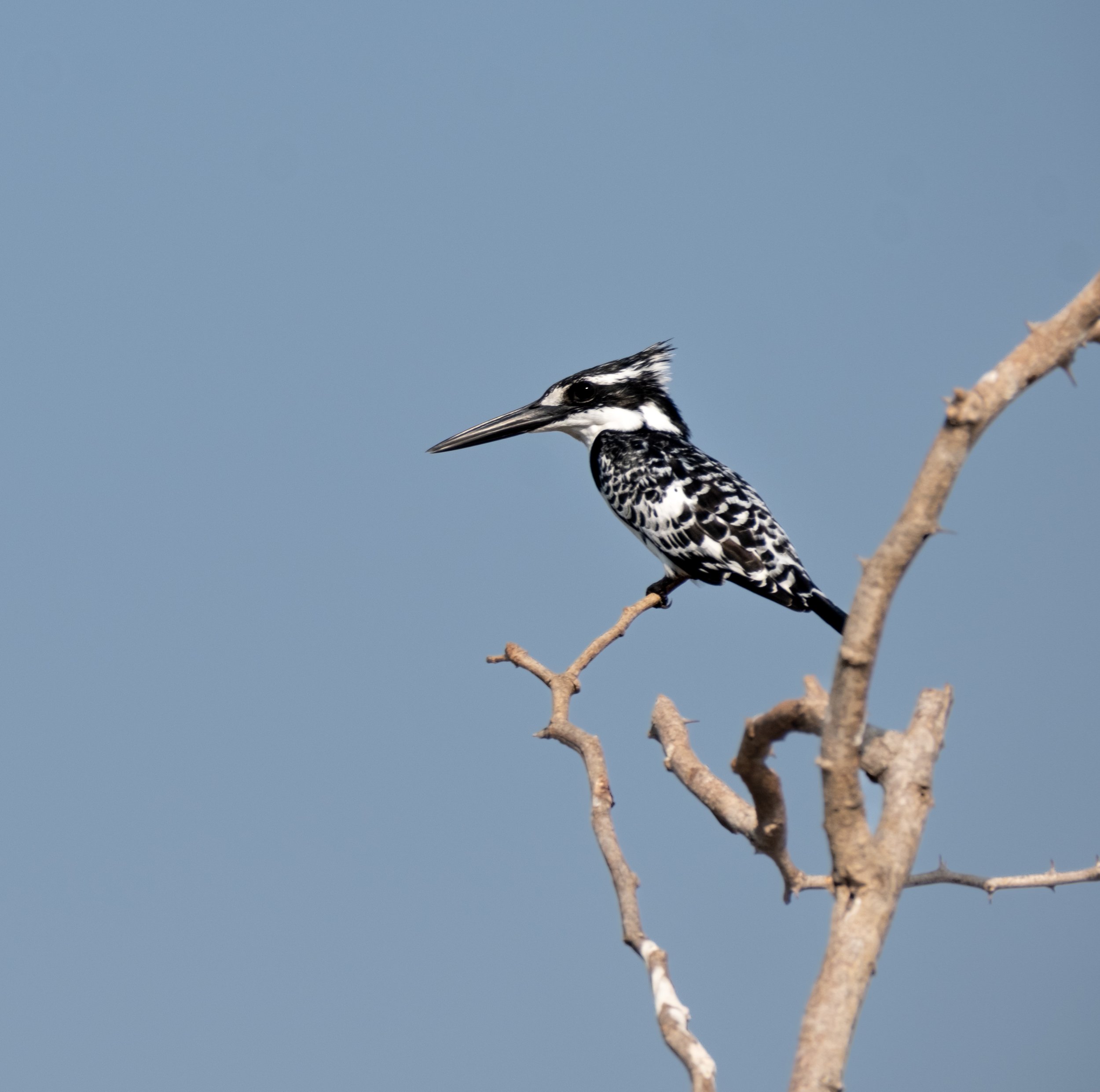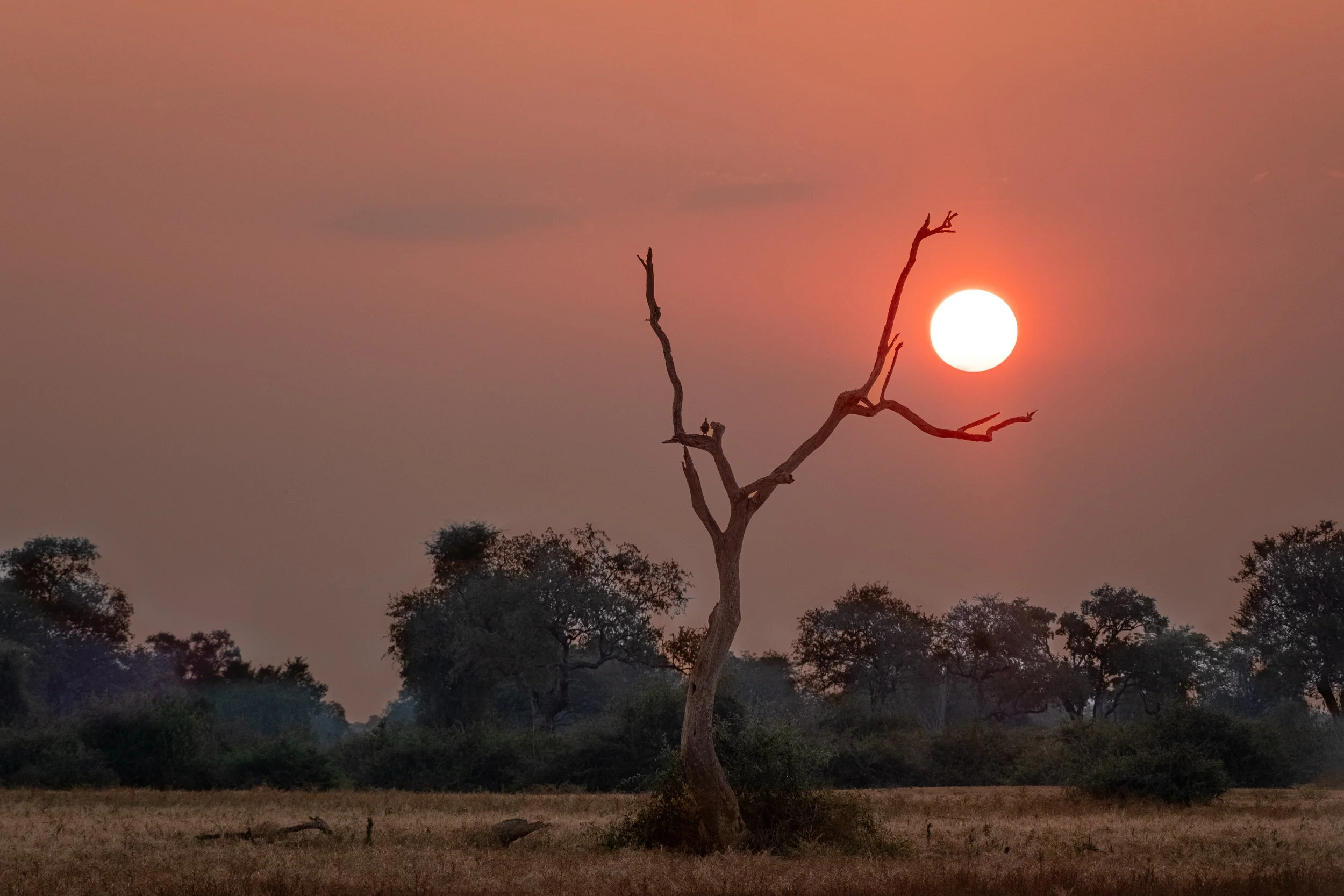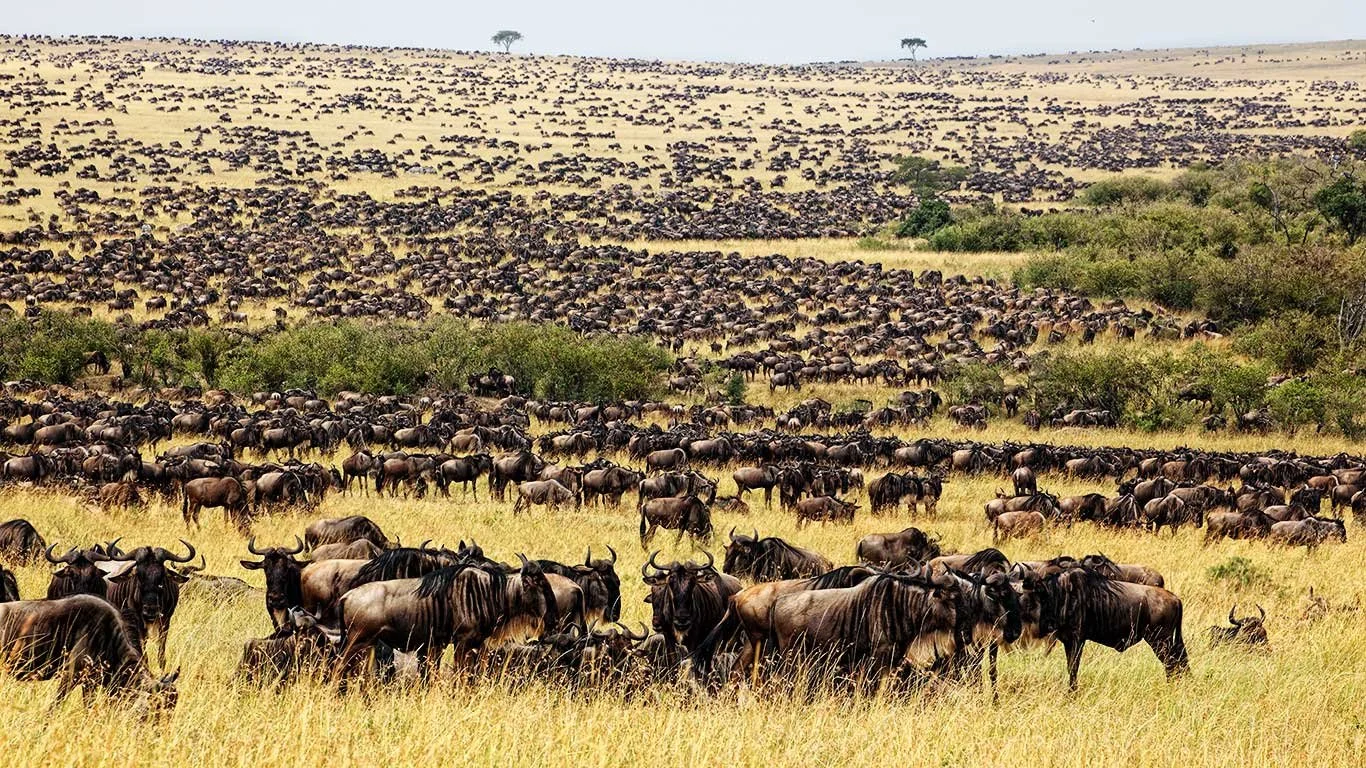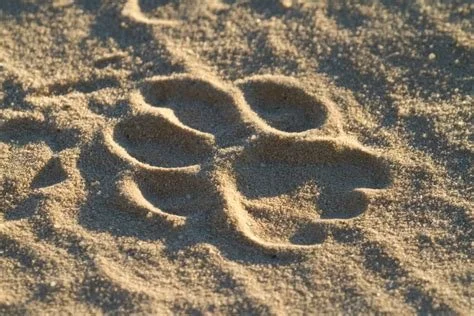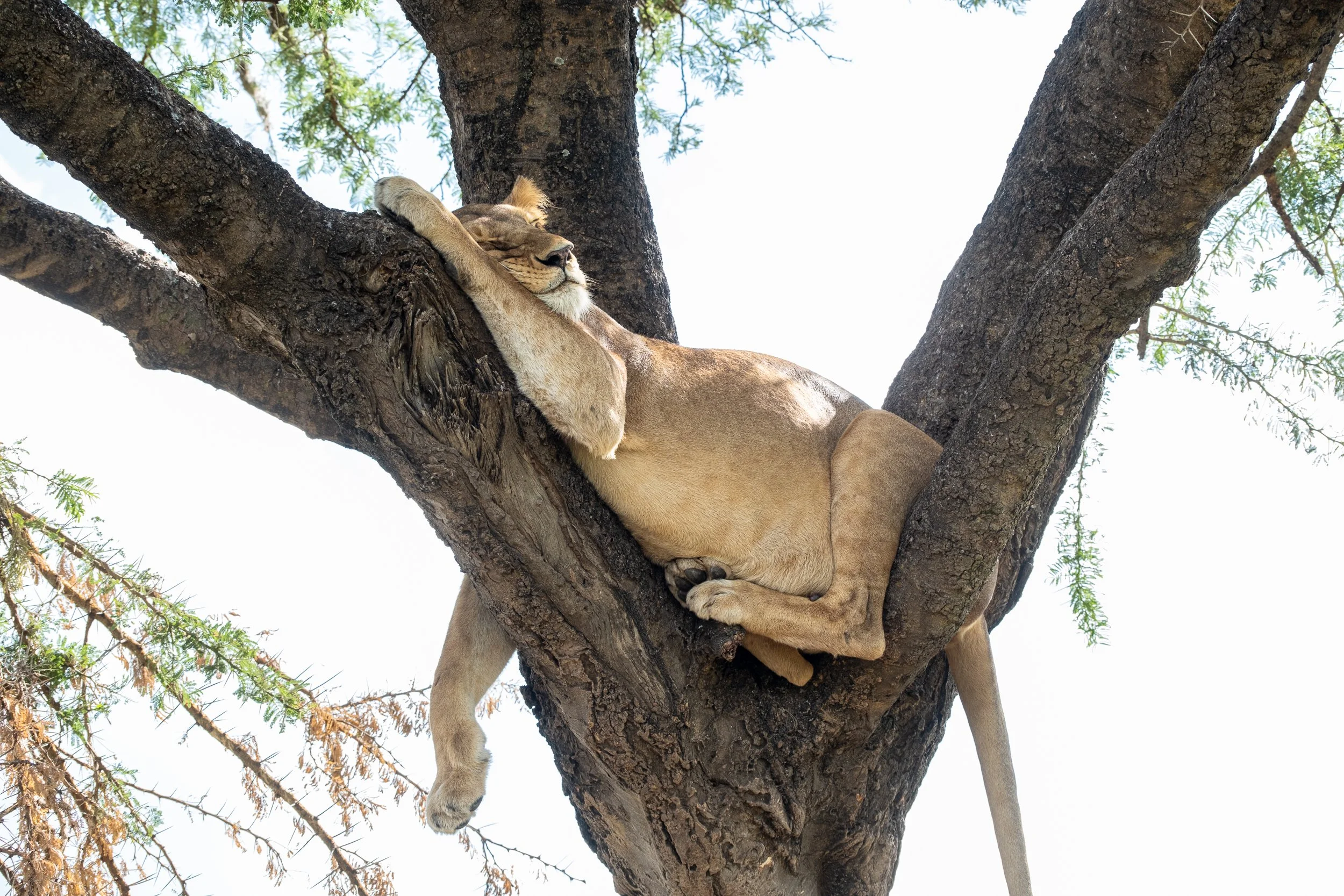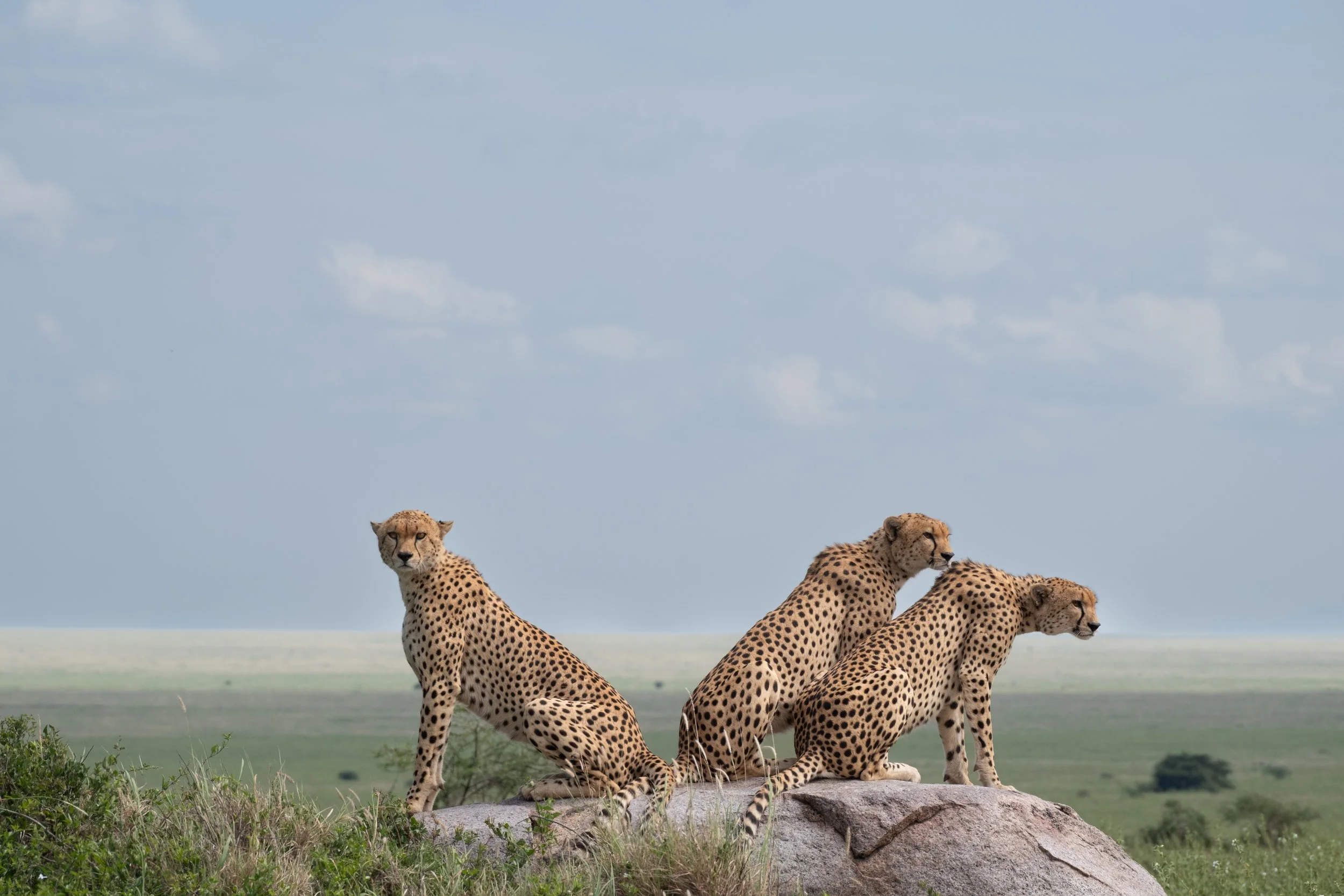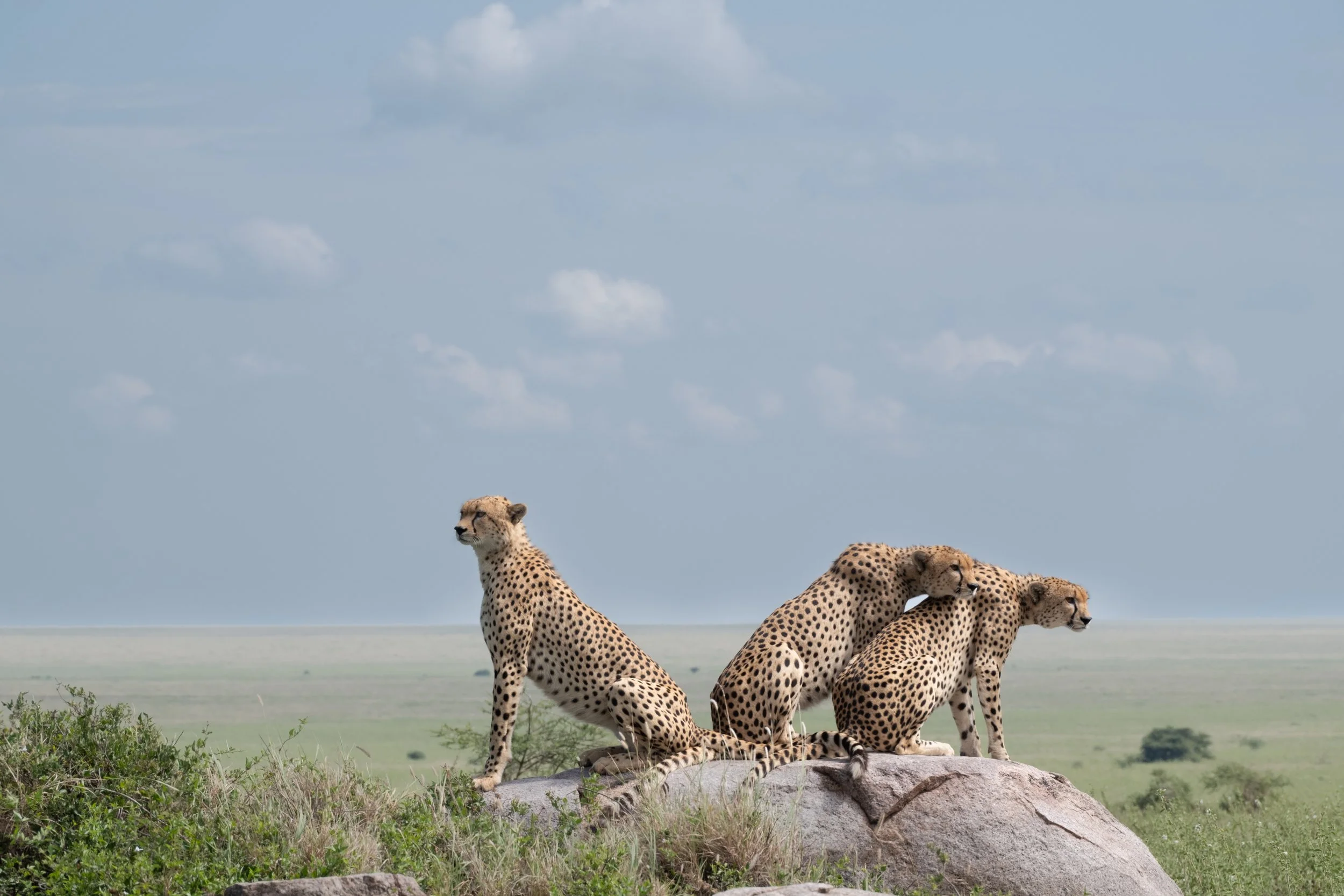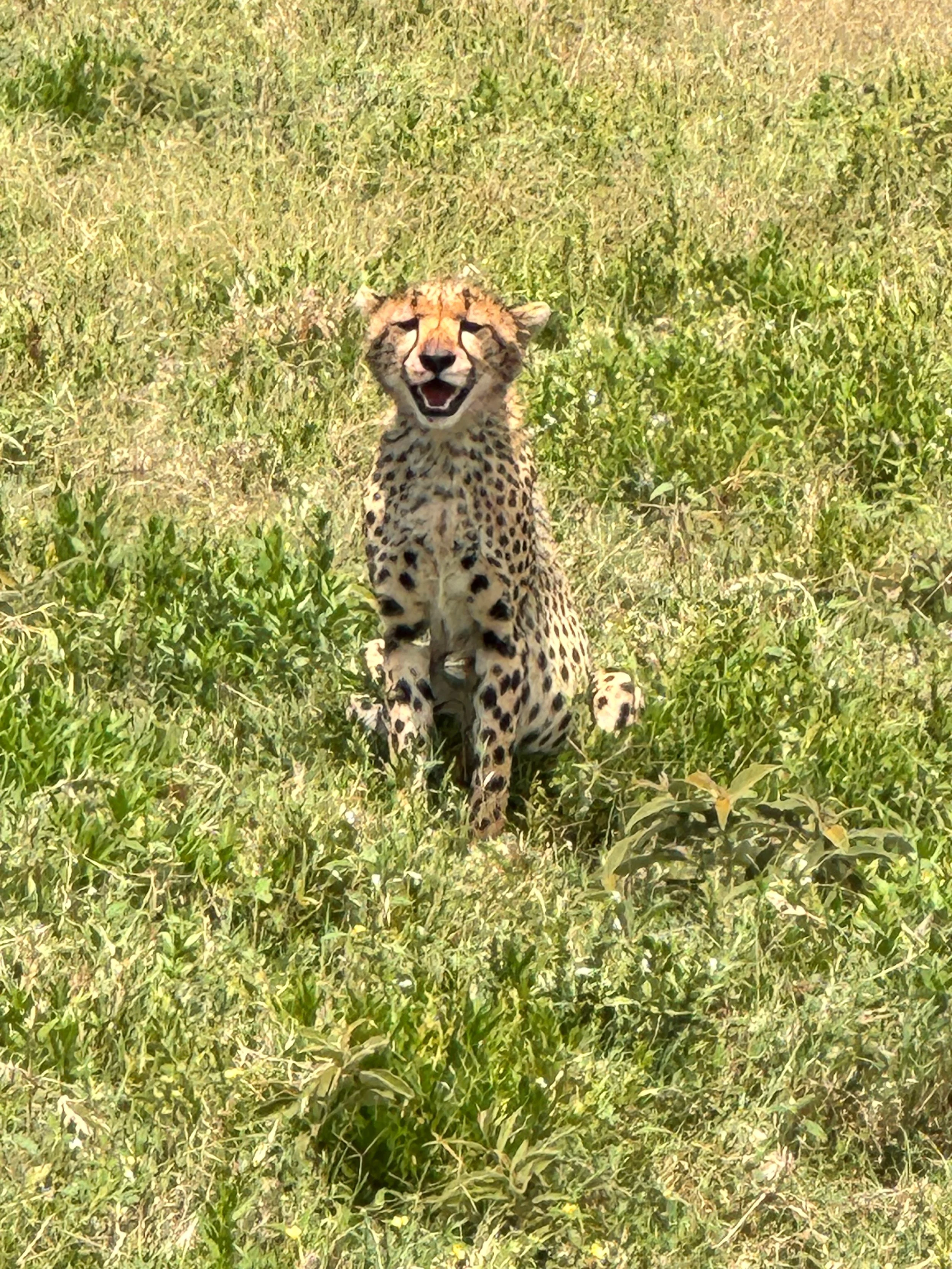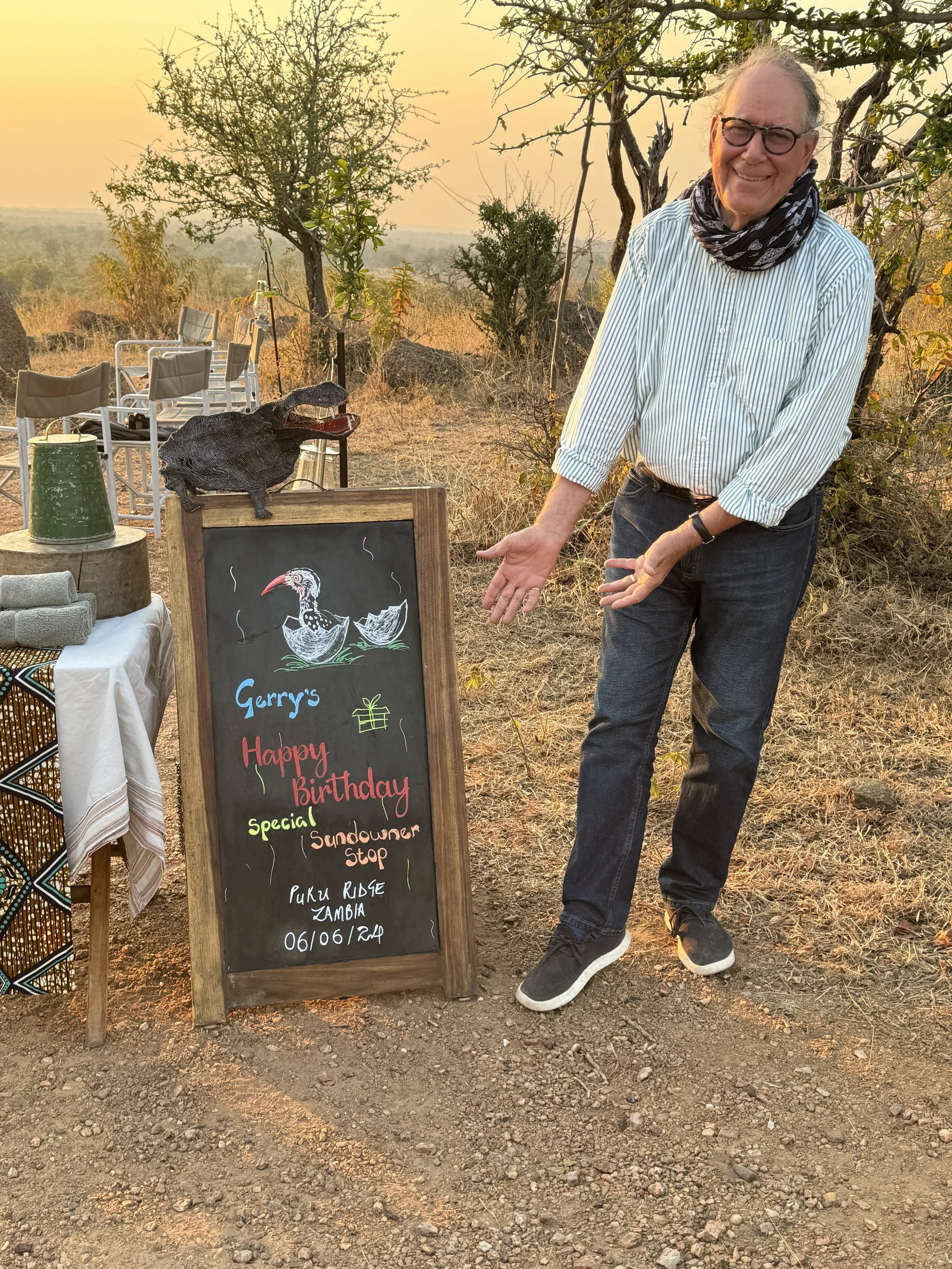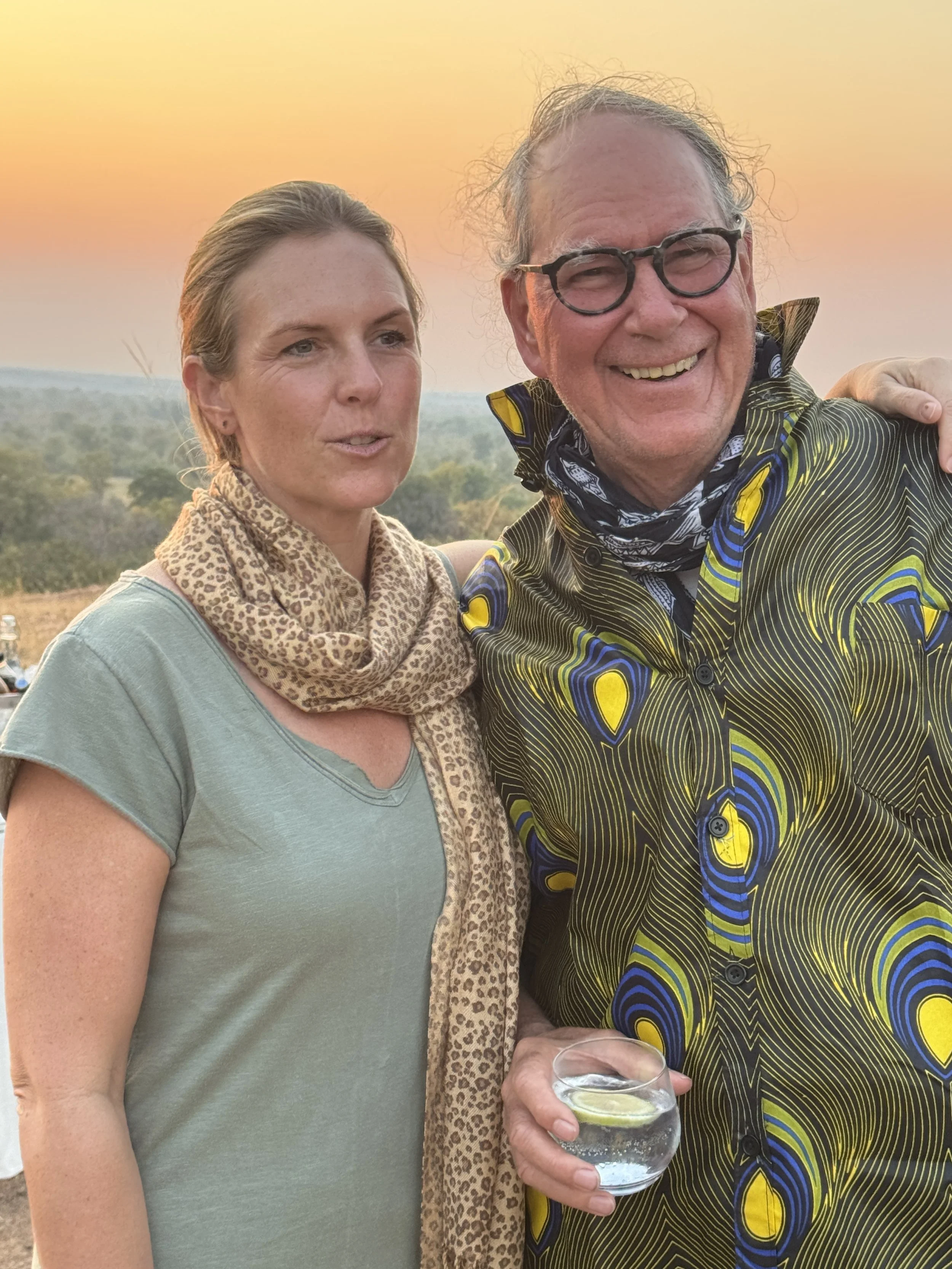Tanzania & Zambia - May 20/ June 11, 2024
Predatory tree devouring the sunset, Zambia
How to describe two and a half weeks in the Serengeti and in Zambia? Not easily done.
Why did I wait so long to file dispatches? We were off the grid for virtually all of that time and although we were nominally able to access wifi at intervals during that period, the signal was so fragile and we were so tired from our expeditions that mustering the patience to deal with a ragged wifi connection required more than we could manage. Hence my reporting dilemma. So, rather than a documentary, I’ll try to capture some, a very few, of the many bright spots that immediately rise to the top of the memory heap.
I write this just after we have returned and we are ragged with tiredness. Over the course of three weeks away our itinerary took us on 12 flights, many of them in small bush planes landing on dirt airstrips where the pilot often has to buzz the landing strip to chase the animals away. Our return flights required 20 hours in the air and 5 or 6 hours in lay-overs so jet-lagged as I am, I ask forgiveness in advance for all the insults I’m sure to offer to the language and to grammar in the pages ahead.
Superb Starling from V’s iPhone
Memory one
After a long but surprisingly pleasant ride on Ethiopian Airlines from Toronto to the Kilimanjaro airport in Tanzania and a couple of R&R nights in Arusha we left on a small Cessna 10 seater bush plane and landed at the Seronera airstrip in the north-west corner of the Serengeti National Park. During the 3 hour cross-country Land Rover ride to the Nameri Plains camp where we first stayed in December of 2022, we noticed a number of Superb Starlings, superb starling does sound like an oxymoron but surprisingly they are, hovering, screeching and flying in very tight circles mere feet above a spot nearby. We had time to notice this because the roads were a chaos of ruts and holes, now dry, caused by the torrential rains of the rainy season so we were forced to drive at a bone-jarring, walking pace. The starlings were in full danger-warning mode and centred their attention on a very large rut at the side of the road. They would hop to the edge rut, screech and then jump back or lift themselves a few feet into the air and hover, but they were clearly not going to stop alarm calling until the danger was past. After stopping and watching this for 4 or 5 minutes, the source of the danger, did eventually pour itself out of the rut and into the grasses of the savanna. It was a very large puff adder as thick as my upper arm and about a metre and a half long which had stretched itself along the bottom of a very large rut deep enough that we were unable to see it. The hair did stand up on the back of my neck. Unfortunately we had just unloaded our bags from the plane so I did not have my cameras to hand, but the memory will last me for a very long time.
Photo courtesy of the Elewana Collection
Memory two
Seeing the beginning of the annual animal migration in the Serengeti. During our week at Namiri Plains, the head of the annual migration was just starting to arrive in our section of the Serengeti. Very early days but you could get a sense for the magnitude of the river of animals that would be in full spate over the next couple of months. As they follow the rains from the southern Serengeti, the animals travel hundreds of kilometres and cross many rivers from the southern Serengeti in Tanzania across the border into Kenya and into the Masai Mara. Over 2 million wildebeest and zebras as well as a host of predators, lions and cheetah and all the assorted scavengers and plunderers who join the feast, make a massive annual trek to keep pace with the fresh grasses and pasturage that the rains bring. It is stunning in its enormity and seeing even the beginning of the trek is awe-inspiring. When we arrived and drove from the airstrip to our camp, the savanna contained the usual numbers of antelope in herds, Thompson and Grants gazelles, topis, hartebeest, elands and kudu, nothing out of the ordinary. But as we went exploring in our Land Rover over the week we noticed more and more wildebeest and zebras in very large groups beginning to be scattered across the landscape. When we drove to the airstrip to leave on our last day, we looked north and there across the horizon was a long black line of animals slowly walking their way across the landscape. A thin black line that held the promise of the millions that would soon be filling the countryside as far as the eye could see.
Zebra beginning to collect for the Migration ahead of the wildebeest
Memory three
One of the pleasures and interests that have taken us to the particular places that we have visited in Southern and East Africa is seeing and spending time with big cats but more especially with cheetah. I have always been fascinated by these animals certainly by their skills, speed and lithe beauty but also by the very narrow ecological niche that they fill, it’s almost surprising that they continue to exist at all. They have only one superb capability, their speed. Yes, they also have wonderful eyesight and other useful tools for their trade but speed is their essential and defining characteristic, but they have made an evolutionary bargain which puts them at enormous risk. In exchange for their speed and dexterity they have stripped their body down to a minimum to reduce their mass; their legs are very thin, their body is built for aerodynamics not heavily muscled for defence, they are slender, weighing about 56 kg and to generate their instant speed their metabolism must run at a very high pitch, therefore they need to constantly hunt to fuel up. But because they have traded away their mass and size to gain speed they are the targets for every other predator including all the other cats but more especially hyenas. Racing an antelope at 110 kph and making a kill is exhausting in the extreme but keeping their kill can be an even more demanding problem. They are routinely chased off their meals by hyenas who wait for the cheetah to do the hard work and then take over. An added consideration, they do not live/hunt in groups but like almost all other cats they are solitary, so for a mother cheetah to raise a couple of cubs, the drain on their physical resources arising from the need to continually hunt, can be overwhelming.
Male cheetah often form coalitions with brothers across birth cycles who then hunt as a pack. We have followed coalitions of up to 5 cheetah brothers who hunt this way, which reduces the stress load of solo hunting and can act as a better deterrent when hyena come calling. In fact on our first trip to Southern Africa in 2012 we spent time on a number of occasions, watching three cheetah brothers who worked as a coalition, at Tswalu in the Kalahari. We were surprised and delighted when we returned there in 2022 to see two of the three brothers still together working as a unit. At that point they were about 15 years old, a very impressive age for a cheetah and still in good health but when the inevitable catches up with one of them, the other’s life will be measured in days. For fairly obvious reasons this is not a strategy available to cheetah females so for me the mother cheetah is the heroine of the cat world.
I love all cats but my real passion is reserved for the cheetah, and especially for the female.
Sunrise Lion, Zambia
Male lion track, what we are all on the watch for
Lions, the thugs of the cat world, have sorted this problem out. The males may fight for domination inside the pride but when they go hunting they put all that aside and take the whole family unit to help chase and carry the groceries. In truth, it’s really the females who do most of the hunting but the males are there in a support role and take over the kill as soon as the work is done. The fight for domination begins again over dinner, they are totally self-interested when they eat and the weak go the wall, but they perform as a unit to deliver the meals.
I hope this settles the argument once and for all, lions can and do climb trees, although rarely. Pregnant lioness about 4 metres up in the crook of an acacia.
A coalition of 3 cheetah brothers, surveying the landscape, Namiri Plains, Serengeti
So, while we have followed and spent considerable time with cheetahs over the years, this trip to the Serengeti allowed us to see something that we had never previously seen and which created a highly-charged memory, a successful cheetah hunt. In fact we saw two of these and on both occasions a day apart, they were both carried out by the same cheetah mother.
We found the mother and her two cubs, probably a year or so old, at the bottom of a slight incline with Tommy gazelles in small herds wandering a couple of hundred metres away from the cats and on 3 sides of them, we were on their 4th side. We parked up the slope and downwind of them and along with 4 other vehicles, settled down to watch developments. Both she and her cubs were clearly in need of a good meal, quite thin and bony so at least a couple of days since their last meal. One cub was very engaged and was, like his mother, constantly looking around, checking to see who had spotted them and judging their chances. The other one was in a pitiful state, thin and hungry and calling for food. In fact he wandered up to the vehicles to lie down in their shade. This was not an ideal situation and his cries certainly were not helping mum in her hunting.
Hungry young cheetah cub
Mum and the more robust cub were in a good situation, downwind of all of the antelope so it was a case of trying not to be spotted. Periodically, a zebra would notice them, alarm call and all the antelope would try and spot what and where the source of the alarm call was. They would stay on high alert for 3 or 4 minutes but would eventually calm down and go back to grazing. The hunting process can take quite some time as they painstakingly edge their way to within 70 or 80 metres of an antelope or a small herd without being noticed. Within this distance they are close enough to try, and with their speed and with the element of surprise they can usually capture a meal.
While this process continued, we were swarmed by bees who our guide surmised were looking for a location to establish a new colony and were moving their queen. Apparently they had decided that a safari vehicle might just be the perfect spot for a new hive. We tried moving our vehicle a number of times but the bees persisted. The other vehicles left in short order and we were left to watch the hunt on our own. Personally I do not worry about bees, they do not sting unless provoked so I did not pay them any attention and never felt any concern that we would have a problem. They buzzed and wandered around our vehicle while our guide, who claimed that he too had no problems with bees, wrapped his head in his scarf until only his eyes could be seen and madly sprayed the vehicle, us, the bees and the entire environment with some sort of insect spray which was hugely unpleasant for the human occupants but had no noticeable effect on the bees. V was not having a very happy time, is very nervous around bees and following advice, was desperately trying to subdue her instinct to swat anything that moved.
And then we saw that the cheetah mum had managed to place herself within striking distance of a small group of Tommy gazelles without being spotted and it was going to be a matter of seconds before she moved. I had my camera at the ready but I defy anyone who has not spent years practising, to keep a cheetah racing at 90 or 100 kph, in the viewfinder of a 400mm lens, just not possible. She raced behind her chosen Tommy from our left to our right directly across in front of our vehicle about 20 metres away, the Tommy made a 180 degree turn just to the right of our vehicle and they raced back across our front and then about 30 metres away, it was all over. The more robust cub came racing in help his mum finish the business and did his best while his mum fought for breath, every breath and every heartbeat shaking her entire frame.
The weak and struggling cub was a few hundred meres away from the action where he had wandered off, and was calling for his mother, with no idea where everyone was. Now here’s the remarkable thing, the mother and the other son did not touch the gazelle, hungry as they were but were clearly waiting for the little one to find them. Mum continued calling but the little one didn’t seem to be able to hear her over his own cries. We watched the cub with great anxiety, wondering if he would find them or be picked off by a stray hyena following up on the hunt. It took about 10 minutes as the little cub wandered aimlessly calling for help before he finally heard mum and managed to find his way to the kill. We quite literally cheered when he arrived on the scene and then the three cats made up for lost time and took full advantage of the meal on offer.
The three of us in the vehicle, the guide, V and I agreed to bend the rules in favour of the cheetah family and so we determined that we would stay with the cheetah and if any hyena came along that we would chase them off and give the family a chance to make it through to another day. There are strict regulations prohibiting anyone from interfering with the animals and their natural behaviours so we would very definitely have crossed a line had we done so. Fortunately we did not have to intervene, no hyena having spotted the hunt, so we spent a leisurely 30 minutes watching them make a very good meal. Had we intervened I definitely would not have recorded it in the blog.
Interestingly, while the bees continued to buzz around, during and after the hunt not another word was spoken about them, in fact no one even appeared to take notice of the fact that they were still there. There’s a lesson in there somewhere.
Elephant on the Zambezi River
Memory 4
The first week of our trip was spent on the Serengeti, one of our favourite places in the world, not least because it’s one of the best places to spend time with cheetah. We travelled there because of our classic rationale, ‘since we’re going anyway, we might as well…’. In this case, since we were going to Zambia anyway, we thought that might as well stop in the Serengeti along the way. However, after the Serengeti our next 10 days journey took us, for the first time, to Zambia. Zambia was the location of and the catalyst for the trip. We were there to help our friends Rich and Susie celebrate their engagement 16 years before on the banks of the Luangwa River, a major tributary of the Zambezi River in north-eastern Zambia. And not only their engagement but their successes in the following years including managing a safari camp on the river where Rich proposed, right next to one of the camps where we stayed and the successful travel planning business that Susie has built after their camp management experience. And last but certainly not least, a very happy family partnership with two wonderful kids.
In fact Susie has planned and had a hand in every one of the 7 trips that we had previously made to Southern Africa as well as organizing trips for a large number of friends and family over the years. She is a remarkable woman and we wouldn’t travel to sub-Saharan Africa without involving her.
Rich and Susie under the tree where he proposed
This trip was the first time that Rich and Susie had returned to the area since they had left the camp that they managed so a nostalgic homecoming. Susie had invited a couple of clients who have become very good friends to help them celebrate and so in addition to R&S our group included V and I, two other Canadians, Hazel and her partner Tim and two lovely American women from the Southern US, psychotherapists both who have known each other since university days. Hazel was my successor as CEO of the company that I ran prior to my retirement. She and Tim have also been bitten by the Africa bug and in fact introduced me to Susie in 2011. They are both old Africa hands so it was a very congenial group with a lot of shared experience.
We spent our first 7 days with the group in two camps on the Luangwa River where Susie and Rich were engaged and managed their camp. On our final three days we left the Luangwa River to fly down to the Zambezi River, which forms the southern border of Zambia between Zambia and Zimbabwe. The Zambezi, a river out of my romantic childhood imaginings of Africa, populated by Dr Livingstone and legions of heroic British explorers and formed by Boys Own Annual and Just So Stories, did not live up to my youthful imaginings. In place of the dark, dank, heavily treed and dangerous region of my childhood expectations, it was wide, clear , sunlit and open, bordered by areas of very tall grasses as well as by sections of tall trees and bush. I had expected The African Queen and Humphrey Bogart and instead I found a deceptively pleasant and sunny landscape with nothing threatening to be seen wherever I looked.
Hippo giving us a beady look…
I say deceptively however because we were continually surrounded by the most dangerous mammal in Africa, the hippo. Hippos can run at speeds of over 30kph on land, can weigh over 1500 kilos, and a male hippo’s canine teeth can exceed 50 centimetres in length, but most importantly they are extremely territorial and do not hesitate to charge. Hippos are responsible for more than 500 deaths a year in Africa, more than any other mammal. In fact, in our Zambezi camp two days before our arrival, one of the guests was attacked and killed by a hippo and her companion was severely injured. Needless to say, the staff were in shock but there was no fault on anyone’s part, it was simply a tragic accident. Hippos are not things of beauty, neither are they a creature to be taken lightly.
So let me move from that awful event to one of my top memories of our trip and one that very deliberately did not include hippos. One of the opportunities available to guests at our camp was a canoe trip, the guides insisted in calling them Canadian canoes, on the Zambezi, or at least a small tributary of the river. We could not miss an opportunity like that so on the second day of our stay we were taken by motor boat about 45 minutes up river and into the entrance of the small river channel that ran into the Zambezi. There were 5 of us in three canoes, V and I in one and all three paddled by guides who were familiar with the waters. We were cautioned not use our voices above a whisper and only to speak to the other occupants of the canoe. The river channel fortunately was too shallow for hippo but elephants grazed on its banks in large numbers and there was lots of other wildlife feeding or drinking from the water. We were expected to take about an hour to an hour and a half for the journey but we ended up taking two and a half hours because of the large male elephant pictured above.
He was determined to feed and tear up branches to intimidate us, well aware of the fact that we could not paddle past him, too much of a risk since we would have to pass within a few metres of him. We simply had to wait until he tired of us and moved back into the bush, which he did about 45 minutes later.
It was magical watching him, as was the whole canoe journey. Gliding silently up the river, Cinnamon Chested Bee-eaters and Little Bee-eaters, one of my favourite birds, darting in and out their nesting holes on the river’s bank and a whole variety of birds and animals buzzing, flitting and climbing in and out of the water. One of the best memories of our trip.
memory 5
This was also a trip of birthdays, both prospective and retrospective. Tim’s birthday took place on the day we left camp for the airstrip and the end of our adventure but Susie had organized a cake and a choir of all the staff at the camp to sing a local version of Happy Birthday to Tim on the night before our departure. I’m assuming it was a happy birthday song but the melody was certainly not familiar and lyrics were in the local dialect so not comprehensible. I just feel that the staff was enjoying itself much more than you would expect for a simple birthday song but unfortunately, we’ll never know.
I celebrated my 80th birthday in March but Susie surprised me by arranging a b’day celebration at Puku Ridge, our last camp on the Luangwa before we left for the Zambezi. We were driven out to a hilltop looking over the Luangwa valley for sundowners and everything was setup for a surprise celebration.
That memory will stay with me always, looking out over the mountains lit by the setting sun, surrounded by friends and wearing Susie’s birthday shirt. It was a moment that could happen only in Africa, that’s why we keep returning and that’s why we will most certainly go again.
Final thoughts and random images
I wrote about 5 memories, an arbitrary number, it could as easily have been 10 or 15. So, no mention of leopards, some of the best sightings of any of our trips in both Zambia and the Serengeti. Nothing about our marvellous guides, nor about a pack of wild dogs that we tracked in Zambia. Not a mention of the sunsets and the spectacular scenery, the landscapes and the magic light as we set out at 6am with the sun rising over the Luangwa River. Not a word about our always interesting conversations over dinner, a mix of characters and personalities that ensured that every conversation held small insights and large ideas that lingered long after the meal was over.
No time to talk about baobab trees, a tree which always brings to mind Saint-Exupéry's The Little Prince, and which are huge and ever-present in the Zambian bush. No giraffes, no serval cats, no buffalo. But all grist for another mill on another day.
More to come!







